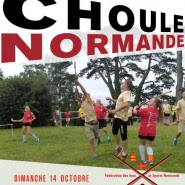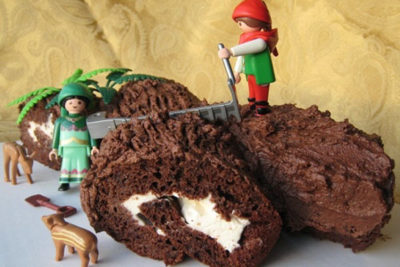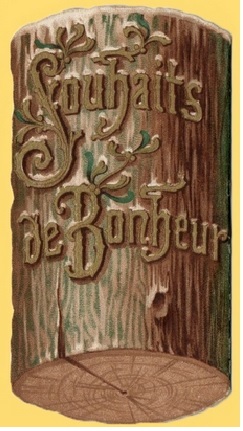In France, Christmas is for family – the extended family. New Year is more for friends. All members of the family bring in, and consume together, the endless Christmas meal on Christmas Eve. The family of our neighbours arrive on motorbikes, in cars and vans, some even on tractors, with in their contribution to the meal. At least one of them brings the traditional Bûche de Noël – their Christmas cake. No need to make one – although some do – because endless variations of the Bûche de Noël are on sale in the boulangerie windows.

Not so in previous centuries, where Christmas was much less festive. It meant hacking down and dragging in the real Bûche de Noël – a section of a tree trunk – to set alight and keep the home warm and the meal cooking. Sophistication of recipes and dishes available today at the butchers and bakers, along with central heating and better living standards since the last century, has put paid to all that slog, allowing the family time to enjoy each other’s company, rather than having to.
As for the holy side of things, only a few of the pretty village churches open up for Mass here in Normandy because of the dwindling number of priests to officiate. Two years ago, 130 priests were ordained in France, slightly more than the previous year, but the number of priests and diocesans in France halved between 1995 and 2015. There were a reported 29 thousand of them in 1995, but only 15 thousand in 2015. Ten thousand were over the age of 65, seven thousand over 75.
Since the separation of the Church and State in 1905, the catholic landscape has drastically change. But, even if churches were the mainstay of communities, and masses – particularly over Christmas – were held everywhere, food was not plentiful then, and families did not get together.
A recent report published by Caen University, shows how a landlord would spend Christmas near Cherbourg in the 1550s.* On Christmas Eve after dinner, his servants drag in the huge Christmas log – la bûche – and ceremoniously set it alight. Then it’s bedtime. But at 2 o’clock in the morning he gets up, this time to go to mass. Masses usually start after midnight. Only when he gets back home from mass does he eat his dinner of sheep’s foot and wine. Then back to bed. Meanwhile, in the neighbouring parish, the servants and villagers play morality games throughout the night. Then at 9 o’clock on Christmas day the landlord returns to church for Christmas mass, after which he just carries on with his everyday tasks. After lunch it’s vespers, and life returns to ‘normal’.
So what happened to the big feast?
It doesn’t happen. No-one in those days thought of inviting members of the family nor of offering presents to anyone on Christmas day; and the idea of a Christmas crib didn’t exist. You couldn’t find a turkey in the farmyard (turkeys were imported from Mexico as of around 1532). Life continued as usual on Christmas day, sharpening the logging saws, keeping the mill going in sub-zero temperatures to prevent the paddle wheels from freezing. Servants were sent out to catch small game and, when the weather was good, the landlord went hunting.
Some would go out for a game of ‘choule’, a kind of ball game-cum-fight between two teams of men, often married men against single men, and which often turned violent. But no-one in those days was bothered about violence on Christmas day. This game of ‘choule’ is still played today, mostly peacefully, with women participating. The game originates from the Manche region of Normandy**.

As for ‘Christmas’ presents, they were handed out on 1st January, the landlord offering them to the women, children and staff. Children went from house to house singing Christmas songs in the hope of getting presents in return.
This is all a far cry from today’s sticky, creamy Christmas Bûche de Noël, from the turkey, the loaded cheese plates and foie gras which adorn the Christmas table, even in modest households up here. And we’re a long way from ceremoniously burning those Christmas tree-trunks. With the introduction of stoves such as Godin’s iron stoves – Godin’s Familistère de Guise is just over an hour’s drive from here – and electric heating (introduced 200 years ago), the long tradition of burning la bûche at Christmas has morphed into extended families getting together and consuming food brought in by everyone and having a good time. Including that cream cake. Cake-makers – pâtissiers – compete with each other for the most imaginative and delicious one. So I suppose one could say the tradition of consuming la bûche, in whatever way, continues.
More on the Log

Lighting the Christmas log, the real wood one which was set alight to keep families and servants warm, most probably originates from the pagan rites which took place during the winter solstice when fires were lit. In Normandy a few hundred years back, and then in some places even more recently, log fires were often lit outside for the poor to come and share the heat; the log – la bûche – was also called the souque, chouquet or chuquet, or the tréfouet– (or tréfeu – a word found in Normandy, Lorraine, Bourgogne and the Bery) which means ‘three fires’, an allusion not only to the Trinity but also to the fact that the log is supposed to burn over the three days of Christmas if not longer, right up to the New Year, or even beyond to the Epiphany on 6 January.
For it to burn so long, the bigger it was, the better. They’d saw off the thickest part of the tree down towards the roots and called it the Christmas stump, la souche de Noel or the coque de Noel. It was called the first log, the second, and so on up to the 50th and beyond – according to how many years the father of the family had presided over the lighting ceremony. The family and servants first kneel and pray round the cinders kept from the previous Christmas’ log, then more to the new fire. The adults hide little surprises for the children at each end of the log. On Christmas night it was believed that Jesus came and slipped little presents into all the clogs. Clogs were called Chabots in Norman dialect (sabots in French) and Jesus’ presents, called chabotées, consisted of apples, oranges and baby comforters.
Sometimes the poor would gather round the log fire before going to midnight mass. The poor and the clergy were often offered logs as presents at Christmas.
The way the log burned, either slowly, surely, or spitting, was up for interpretation; it announced what the New Year would bring. A fruit tree log was believed to ensure a good harvest of fruit in the coming year; the smell of the wood had its importance – apple wood, abundant in Normandy, renders a sweet odour when burning. The tree had to be cut down before sunrise and the log was sometimes decorated with leaves and ribbons. Cinders from the log fire were kept to protect the house from lightening and protect sick people from disease.
During midnight mass, it was believed, all animals kneeled down. But, as the superstition went, keep away from them, because the animals will turn on you. It was also believed that bread blessed on Christmas night protects you from rabid dogs, although if you give some of it to a dog he’ll actually catch rabies…***
And to finish:
Snidbit number 1:
It was on Christmas day 1066 when William the Conqueror, Duke of Normandy, was crowned King of England in Westminster Abbey. The English and French who were present cheered the new King so loudly that the clamour alarmed the French soldiers waiting outside who, exhausted after combatting the English, panicked and set fire to houses around the abbey. Witness reports say that only a few – terrified – people, bishops and clergymen and a petrified William the Conqueror, were left in the abbey where William nevertheless managed to make his speech for peace, justice and Christianity in a halting Anglo Saxon he hardly understood himself. He was then duly crowned in an almost empty Abbey while outside the riots raged. Not much of a Christmas day…
Snidbit 2:
Here is a Christmas poem in Norman patois. In our region the patois is called cauchois and it is still spoken today. When my elderly neighbour gets carried away telling stories in this almost lisping dialect I have to keep asking her what some of the words mean. This Norman Christmas poem is about the Nativity. Those of you who have a certain mastery of French may be able to decipher the meaning if you can get your head round the patois pronunciations.
« Nativité »
Veisinsn veisinn’ s, Vuul’ s gens, jann’ s gars,
Halez vos gaumb’ s d’ entre les draps,
Mouortrez la tête à la luquerne
Et d’ valez trachi vot’ launterne;
Sortez touos dé d’ dauns vot’ maisoun
Malgré l’ heur’, malgré la saisoun
Ao noum du Bouon Dieu qui vous aime
V’ n’ ous en do nous à Bethléyème !
And … snidbit 3:
It was a Norman Jesuit missionary, Jean de Brébeuf, who composed a Christmas song for the Hurons in Canada in the year 1641.

Jesous ahatonnia (Jésus est né; Jesus is born) was written in the Huron language Wendat and is the oldest sacred music Christmas song in Canada. It is still sung today. You can listen to it here, and follow the words – below is the first stanza in Wendat, then in French:

Ehstehn yayau deh tsaun we yisus ahattonnia
O na wateh wado:kwi nonnwa ‘ndasqua entai
ehnau sherskwa trivota nonnwa ‘ndi yaun rashata
Iesus Ahattonnia, Ahattonnia, Iesus Ahattonnia
in French :
« Chrétiens, prenez courage, Jésus Sauveur est né!
Du malin les ouvrages À jamais sont ruinés.
Quand il chante merveille, À ces troublants appas
Ne prêtez plus l’oreille: Jésus est né: In excelsis gloria!
Happy Christmas ! Bouon Noué ! Bon Noel!
________________________________________________________________
*J-P Bourdon, Pôle rural-MRSH/Maison de la Recherche en Sciences Humaines, Caen
** Today choule is still played in the North of France. See: http://www.jeuxpicards.org/choulemahon.html
***See Abbé Migné’s dictionary of superstitions Dictionnaire des superstitions, erreurs, préjugés et traditions populaires (1856)
****Cauchois originates from the Pays de Caux in the Seine Maritime Département of Normandy.
The Association La Chouque here in Normandy meets regularly to speak the language together and keep it alive.
A Norman patois dictionary can be consulted online here:
A book written in the local Norman patois of the region around Pont Audemer, in the Eure, can be found here.
Thanks to histoirenormande.fr for a wealth of information on historical Normandy.
Featured image: Le Petit Journal illustré du 27 décembre 1908 – Le marché de dindes et des oies en Normandie | © Gallica BnF

